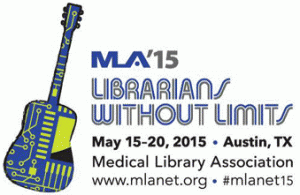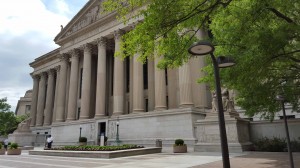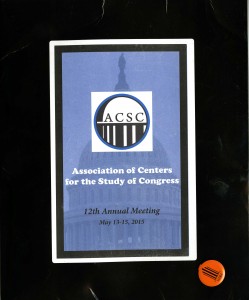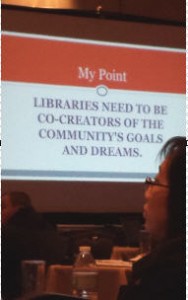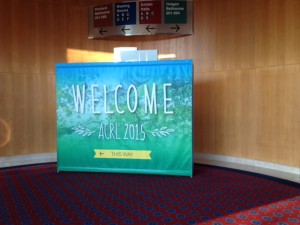On March 15, Stan and I joined about 400 ILLiad users from the four corners of the globe as well as Atlas and OCLC staff to attend the International ILLiad conference in Virginia Beach.
The keynote speaker was Mary Sauer-Games, Vice President of Product Management at OCLC. Her talk was focused on Millennials, who have high expectations for quality and speed. They expect a response in 10 minutes; to meet this expectation you need to be filling with your own collection if available. To meet Millennials where they are, libraries should be using social media: ILL could share trending titles and subjects, instructional videos, etc. Use responsive design. Check out OCLC’s Geek the Library program. Yet, despite the expectations for rapid turnaround times, Millennials still prefer print to e-books.
In “Writing a Comprehensive ILL Operations Report: Methods, Data, and Results” we heard about looking at and charting your operations across the board: ILL print PDA, ILLiad, consortia comparison, different systems, shipping, staffing (which we do!). Year to year comparison examples were shown. It’s important to share your story, to show how and why metrics change (e.g. due to staffing, systems, and policies) and how those factors affect your metrics. Part of the story is not the story.
“An ILL Practitioner’s Role: Advocating Open Educational Resources” talked about textbooks and ILL. Textbooks are problematic: hard to get back from patrons; fill rates are low, arrivals delayed; many become non-returns or overdue. Partner with your campus bookstore, collection development team, acquisitions department, circulation and reserve. Lots of statistics were shown to back up need for open access. You can retain, reuse, revise, remix, redistribute. Free or low cost to print. Many are peer-reviewed and high quality. Different groups doing this were profiled. ILL staff can get involved by providing metrics, lists of cancelled textbooks with faculty; share metrics with student government groups. Add OER sources to your catalog. Reach out to faculty. Award faculty for reviewing books. We’re already doing a lot of this.
In her session “Caught by the Copyright!” Gail Perkins Barton of the University of Memphis presented her library’s strategy for reducing copyright costs. She opened with a discussion of common guidelines and best practices, e.g., including copyright notices on request forms, the “Rule of Two” and “Rule of Five,” etc., and then reviewed the options libraries have to be compliant with copyright guidelines, from denying requests to partnering with document suppliers. The suppliers covered were “ScienceDirect: Article Choice,” “Copyright Clearance Center – Get it Now,” and “Reprints Desk: Article Galaxy.” A price comparison revealed that Article Galaxy was the most economical, and that their turnaround time was excellent. She also showed how these services could be integrated with ILLiad. Another component of this presentation was “Tiered Service” which limits the fees a library is willing to pay according to the patron’s status, e.g., undergraduate vs. graduate vs. faculty. Librarians are also encouraged to take advantage of free resources, previews on publishers’ websites, etc. We already do a lot of this already.
“Managing Courier and Reciprocal Borrowing Relationships” addressed and provided solutions to the problems that may arise when a library is engaged in multiple consortia. Different fee structures, loan periods, and delivery methods can all conspire to complicate relationships with partner libraries. (We encounter this with libraries in CT who use both OCLC and the state library system to place requests.) The presenter, Jen Salvo-Eaton, University of Missouri – Kansas City, demonstrated how ILLiad and the Customization Manager can help manage these relationships, through the use of routing rules and group assignments, customization of templates, etc. She also recommended using statistics to evaluate the quality of service provided by partner libraries – and not anecdotal evidence. Stats can be especially helpful when considering/justifying leaving or joining a group.
The Atlas Systems update session was informative. In May ILLiad 8.7 becomes available. This is a maintenance release and will have many behind the scenes improvements. 8.5 will no longer be supported. Genie Powell also discussed Atlas Systems’ role with ArchiveSpace as a registered service provider, additions to the video training library, and the concierge service.
In “Half the Work: Circulating Lending and Borrowing Requests from ILLiad in Alma Using NCIP,” Northwestern shared their story. They implemented NCIP in Alma for ILLiad and turned on both borrowing and lending options. Using Z39.50, you can circulate ILL borrowed loans in Alma; in lending it precludes you from having to check lending items out separately in Alma. It moves the lending request from a permanent location to the resource sharing library (lending check out item). Upon return it moves it from the resource sharing library (lending check in item). The ILLiad addon sends messages to Alma when records are updated via event handlers in ILLiad. In borrowing, it creates a brief record for the loan and ties it to the patron (borrowing accept item). Upon return, the system deletes the brief record and disassociates it from the patron (borrowing check in item). All ILLiad machines must have the addon. You must disable all Alma notifications. Lending is easier to deal with than borrowing, which is complex. Despite some frustrating experiences, the presenter said he was glad they went forward with the integration, and proposed the formation of support group for librarians interested in integrating Alma and ILLiad.
We all met to hear about OCLC updates with Katie Birch. Many libraries have updated their days to fill to 1-2 days, an excellent example in resource sharing commitment. Multiple address issues have been fixed and mis-shipped errors have greatly decreased. Outstanding glitches should be fixed shortly. Lenders can now refund any request that has been set to shipped and charged with IFM; only the full charge can be refunded. Once the charge or refund has occurred, no further charges or refunds can be actioned on a given request. Available reports were reviewed. Questions about symbol consolidation and satellite instances are encouraged and can be submitted to Tony Melvyn. Remember that your symbol should follow your time to fill commitment: if you share a symbol with an off campus repository, your time to fill should reflect the true time to fill implications. ILLiad has lots of reports on borrowing and lending, take advantage of them (which we do). Use www.oclc.org/community (the OCLC Community Center) to make enhancement requests, ask questions, get news and documentation, and order IFLA vouchers. Also member forums.
Poster presentations were shared at the social. I presented “Smart CATs: Cancelling Textbook Requests the Smart Way,” which outlined our process for cancelling students’ requests for textbooks ordered for UConn classes. Staff from Emory and Maryland called it brilliant. Atlas rather amusingly placed my poster next to one by William Gee of East Carolina University; William was presenting on why obtaining textbooks is a good idea. We had a lot of laughs about that, I can tell you. It was also an impromptu meeting of the Patrick Carr Fan Club. Also visiting my poster was my old student worker (and Dave Moroch’s granddaughter) Alyssa Grimshaw, who now works at the Yale Medical Library. In the photo I’m talking with Marie Hansen from Emory.
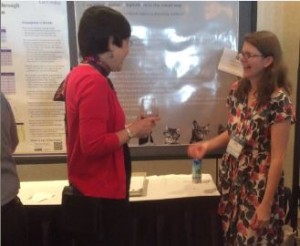
In “ILL by the Numbers: Using Custom Searches and Statistics to Increase the Noticeability of Your ILL Department,” we learned more about searches and reporting. You should keep metrics and provide reports to keep conversations going, keep you relevant. Make your data available (which we do). Examples were shown. You can customize and share these with library staff who don’t come to you.
Stan gave his presentation, “Stop saying No: Improving Fill Rates and Reducing Lending Denials in Interlibrary Loan,” which, along with the other sessions, is viewable on the Atlas Systems’ training site. Attendees responded with numerous questions and comments. The photo is below: he had a full house.
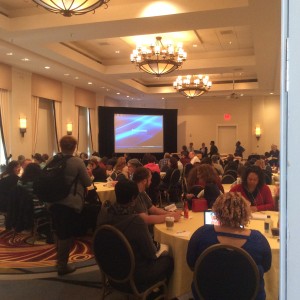
In “Unlocking the Interlibrary Loan Code for the United States,” we learned about the latest undertaking of the Code revision, headed by Ohio State University. It will now be updated every 7 years to keep it current.
Its purpose: to establish principles to facilitate requesting and regulate the exchange of materials. It only applies to US libraries; international code is dictated by IFLA. The Code pertains to all library types and sizes and is system-neutral. The original code is 100 years old this year and began as the Code of Practice in 1916. Interesting quotes were shared from the original code.
What to do now: make sure your local practice and policies are not in violation of the Code.
Reminders:
- ILL is for single patron use and not for groups or classes
- Use secure packaging, no staples, and no labels on books
- Ship to correct location
- Pay attention to the redefined due date which eliminates shipping
- The main intention for interlibrary loan is for when you do not have a local copy, or if your local copy is unavailable: missing, damaged, checked out, etc.
- ILL with other countries is encouraged
- Requesting library must specify special requirements, comply with copyright law, be aware of related guidelines (CONTU)
- Pay promptly for lost materials, request renewals before due dates when possible
- Generous loan periods are encouraged as well as lending without fees
- If you do bill, do so promptly
- Fill all formats
- Work with those responsible for negotiating licenses to include favorable ILL terms
In “The Request Must Flow: Practical Workflows for Resource Sharing across Multiple Locations,” Binghamton University’s Melissa Perez recounted the library’s challenges with processing ILL requests at different locations on campus. She emphasized the importance of regular communication between staff, which she facilitates through “Resource Sharing Roundtables” (similar to our RCL DD-ILL summer meetings), and consistency between the locations with regards to policies and workflows.
The conference concluded with its regular “Unconference” session. Attendees suggested topics which they could then discuss as designated tables. Stan spent quite a bit of time at the RapidILL table, and shared our experience with the RapidR program.





